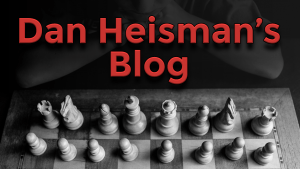Q&A with Coach Heisman Aug 2, 2013
"Show the first 14-15 moves of a Sicilian Dragon and explain the main ideas of some of the moves" (!) Hmm. They write entire books about sub-variations of the Yugoslav Attack (like Mayer's book on the Soltis variation) and I am supposed to show the first 14-15 moves?!
Well, before attempting this feat, this at least triggered me to ask the trivia question "Against whom did GM Soltis first play a tournament game featuring his famous ...h5 variation of the Yugoslav Attack in the Sicilian Dragon?" The guesses included Kasparov, Karpov, Fischer, Morphy, Paulsen, Bronstein, Barczay, Bisguier, and quite a few others. Nope. The answer is me (!) on Dec 4, 1969 - and here's a link to my column Learning From Andy, where I give the game.
During the show I took 5 minutes and reviewed a main variation or two. Here's a game I played (lamely) with the Dragon, back when the theory was being developed:
I got more of those standard "Is the Trompovsky a good opening for a 1700 player?" questions. As always, I gave my little standard "good opening" spiel and referred the questioners to my Chess.com article "What's a Good Opening?" I should just copy this paragraph, publish it on the web, and make it a recurring link, too!  A similar ditto for "I am 1700; what do I need to do to get to 2000?" (I think some ask this just to see my reaction...)
A similar ditto for "I am 1700; what do I need to do to get to 2000?" (I think some ask this just to see my reaction...)
There was a question about diet during a game. Happy to oblige; my website's "Links" page has the following one: The Grandmaster Diet.
"Who would have won Fischer-Karpov?" I presumed the non-played match in 1975. With the assumption that Fischer would not have walked into it "cold" and had some proper warmups, I think Fischer would have been the betting favorite and won. However, there is no doubt that Karpov had strong will good nerves, so the possibility of his winning on a Fischer "blow-up" would not have been infinitesimal, in addition to his normal winning chances. Of course, the older Fischer would have gotten, the more his age would work against him, so by the time Kasparov appeared to play for the World Championship in 1984, Fischer would have been 41 and, in the face of these two historically good, and younger players, eventually his title would have fallen if it had not happened sooner. Father Time beats us all...
One never-before-asked-on-the-show query: "What separates the great players from the nearly greats?" This is the kind of question begging a simple answer where there is none. Let's assume for a second that the great players are the Top 5 in the world and the nearly great are the next 15 (6 thru 20). Aside from the fact that players in the range 6-20 occasionally poke their head into the Top 5, consider the fact that there are dozens, if not more, chess attributes. The separation between say, #1 and #10 could be a single attribute, such as when you hear "Ivanchuk had all the ability to become World Champion but he didn't have the nerves" to the more common case where multiple attributes are involved: a player might be able to match or nearly match the world's #1 in many of the traits but just fall short in a precious few, enough to make the difference. So there is clearly no "easy" answer such as "The great players have the will to win and the others fall short" or "The great ones put in that extra work and want it just a little more badly". While in some cases these may be generally true, in any individual case the actual answer is probably more subtle and complex. I could spout about the great ones having this or that attribute, but that's all it would be, spouting - those near greats are pretty good, too...sometimes it doesn't take much...
Someone asked how my wife Shelly felt about chess. I gave an answer but, now that she is home, let me call downstairs and get her to come up and give a quote (I have no idea what she will say!):
Shelly: "Hmm. I think it's a great mental sport, a great activity. And...I wish I had the patience to play it." OK, that doesn't match what I said on the show (which now becomes irrelevant), but it's a much more accurate answer (if I say straight from the horse's mouth you may never see me again...!)
Someone asked about White playing an early c5 in Queen's Gambit positions. In general this is a bad idea (although sometimes it is tolerable). Black can react two ways: 1)the immediate ...b6 and if b4 then ...a5, or 2)with the usually pseudo-sacrifice e6-e5 breaking in the center. Usually one or both of these is very strong and that's why strong players don't play c4-c5 much in these positions. I wrote about this a little bit in It's Not Really Winning A Tempo (one of my favorite columns).
Someone else asked about Break moves. Here I have lots of material such as the aptly named Break Moves: Opening Lines to Create Mobility. I also referred the viewers to the classic Kmoch book Pawn Power in Chess. In those days "Break Move" was not yet standard so Kmoch called these "Liberating Levers"! Despite his nomenclature, he gives ~40 excellent pages on explaining this concept. Importantly, break moves can be a key part in the opening, middlegame, and endgame, and there's not too many positional maneuvers which meet that criteria. Break moves are one of the few "sophisticated" positional concepts almost everyone needs to know to achieve at least intermediate level strategic play. For what strategies I suggest you need to carry up to higher intermediate play, check out How Much Strategy to Start? (this column's gotten really good feedback!), but after Aug 20 Chess Cafe would require you to pay 99 cents to read the same column archived at this link. So save yourself the big bucks by reading it before then; I can almost guarantee you won't be disappointed  .
.
The next "Q&A with Coach Heisman" show Aug 16 will be open to all. Cya there.






